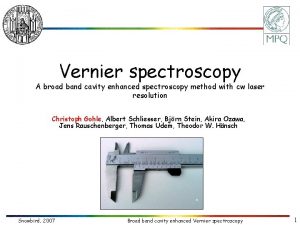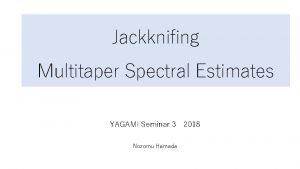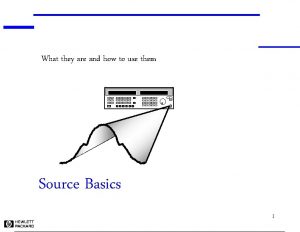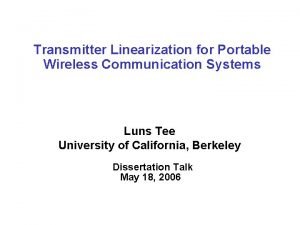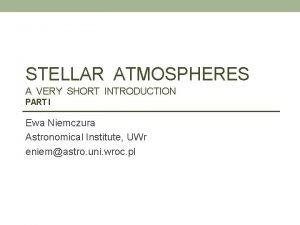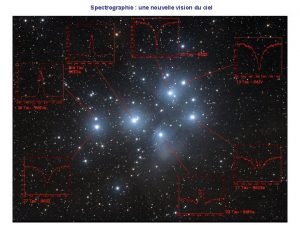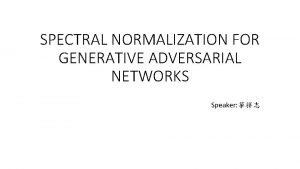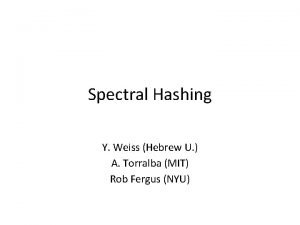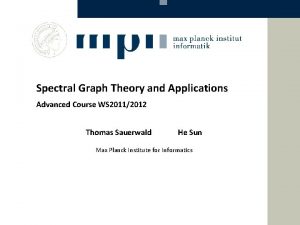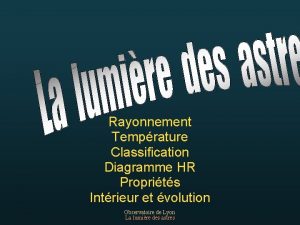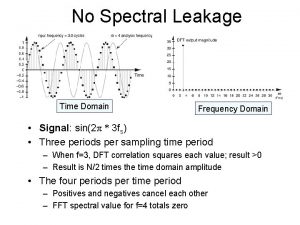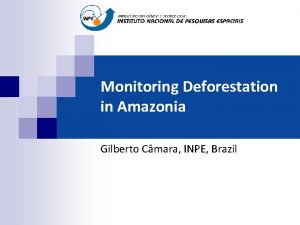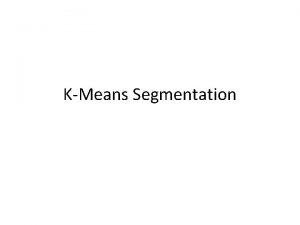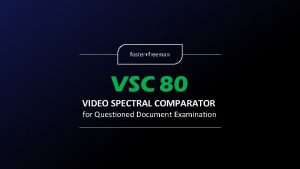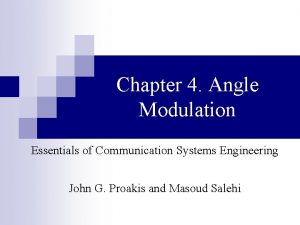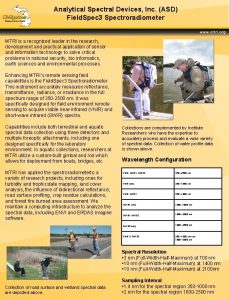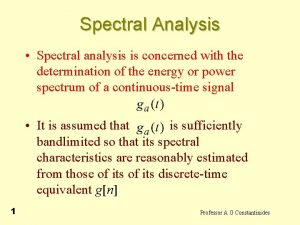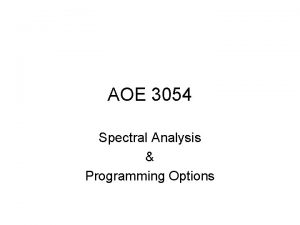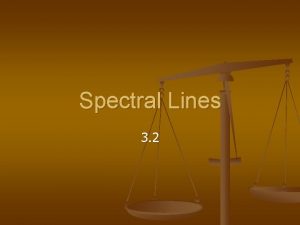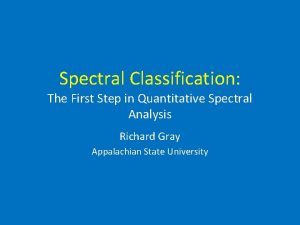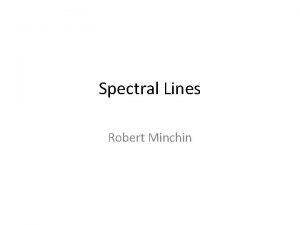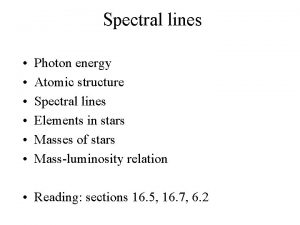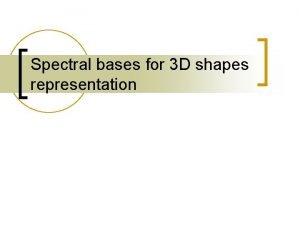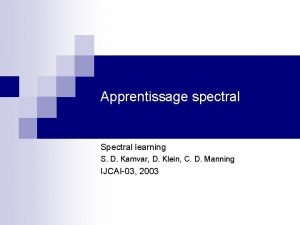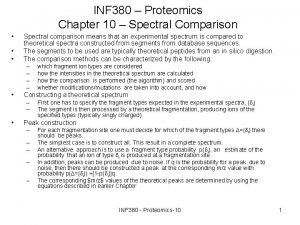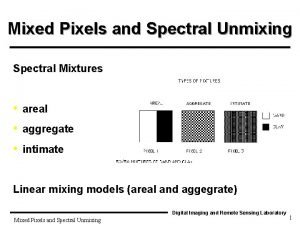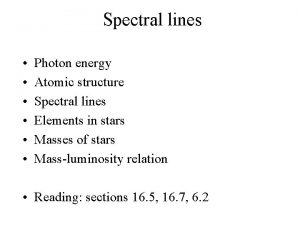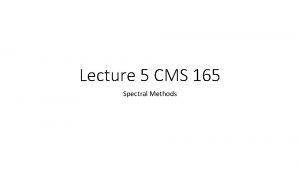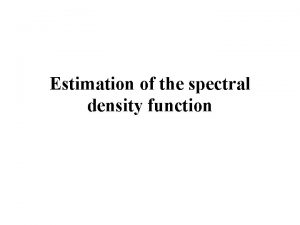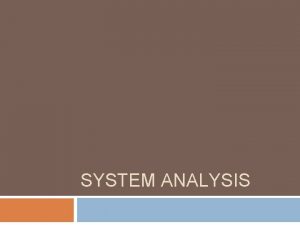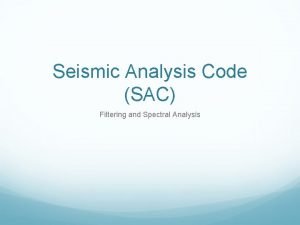Spectral Analysis Spectral analysis is concerned with the




![Spectral Analysis of Sinusoidal Signals • Initially the infinite-length sequence g[n] is windowed by Spectral Analysis of Sinusoidal Signals • Initially the infinite-length sequence g[n] is windowed by](https://slidetodoc.com/presentation_image_h/e87849d590a845a4880dc150432823cf/image-5.jpg)






















- Slides: 27

Spectral Analysis • Spectral analysis is concerned with the determination of the energy or power spectrum of a continuous-time signal • It is assumed that is sufficiently bandlimited so that its spectral characteristics are reasonably estimated from those of its discrete-time equivalent g[n] 1 Professor A G Constantinides

Spectral Analysis • To ensure bandlimited nature is initially filtered using an analogue antialiasing filter the output of which is sampled to provide g[n] • Assumptions: (1) Effect of aliasing can be ignored (2) A/D conversion noise can be neglected 2 Professor A G Constantinides

Spectral Analysis • Three typical areas of spectral analysis are: • 1) Spectral analysis of stationary sinusoidal signals • 2) Spectral analysis of of nonstationary signals • 3) Spectral analysis of random signals 3 Professor A G Constantinides

Spectral Analysis of Sinusoidal Signals • Assumption - Parameters characterising sinusoidal signals, such as amplitude, frequency, and phase, do not change with time • For such a signal g[n], the Fourier analysis can be carried out by computing the DTFT 4 Professor A G Constantinides
![Spectral Analysis of Sinusoidal Signals Initially the infinitelength sequence gn is windowed by Spectral Analysis of Sinusoidal Signals • Initially the infinite-length sequence g[n] is windowed by](https://slidetodoc.com/presentation_image_h/e87849d590a845a4880dc150432823cf/image-5.jpg)
Spectral Analysis of Sinusoidal Signals • Initially the infinite-length sequence g[n] is windowed by a length-N window w[n] to yield • DTFT of then is assumed to provide a reasonable estimate of • is evaluated at a set of R ( ) discrete angular frequencies using an Rpoint FFT 5 Professor A G Constantinides

Spectral Analysis of Sinusoidal Signals Note that • The normalised discrete-time angular frequency corresponding to DFT bin k is • while the equivalent continuous-time angular frequency is 6 Professor A G Constantinides

Spectral Analysis of Sinusoidal Signals • Consider • expressed as • Its DTFT is given by 7 Professor A G Constantinides

Spectral Analysis of Sinusoidal Signals is a periodic function of w with a period 2 p containing two impulses in each period • In the range , there is an impulse at of complex amplitude and an impulse at of complex amplitude • To analyse g[n] using DFT, we employ a finitelength version of the sequence given by • 8 Professor A G Constantinides

Spectral Analysis of Sinusoidal Signals • Example - Determine the 32 -point DFT of a length-32 sequence g[n] obtained by sampling at a rate of 64 Hz a sinusoidal signal of frequency 10 Hz • Since Hz the DFT bins will be located in Hz at ( k/NT)=2 k, k=0, 1, 2, . . , 63 • One of these points is at given signal frwquency of 10 Hz 9 Professor A G Constantinides

Spectral Analysis of Sinusoidal Signals • DFT magnitude plot 10 Professor A G Constantinides

Spectral Analysis of Sinusoidal Signals • Example - Determine the 32 -point DFT of a length -32 sequence g[n] obtained by sampling at a rate of 64 Hz a sinusoid of frequency 11 Hz • Since the impulse at f = 11 Hz of the DTFT appear between the DFT bin locations k = 5 and k = 6 • the impulse at f= -11 Hz appears between the DFT bin locations k = 26 and k = 27 11 Professor A G Constantinides

Spectral Analysis of Sinusoidal Signals • DFT magnitude plot • Note: Spectrum contains frequency components at all bins, with two strong components at k = 5 and k = 6, and two strong components at k = 26 and k = 27 12 Professor A G Constantinides

Spectral Analysis of Sinusoidal Signals • The phenomenon of the spread of energy from a single frequency to many DFT frequency locations is called leakage 13 • Problem gets more complicated if the signal contains more than one sinusoid Professor A G Constantinides

Spectral Analysis of Sinusoidal Signals • Example • - 14 • From plot it is difficult to determine if there is one or more sinusoids in x[n] and the exact locations of the sinusoids Professor A G Constantinides

Spectral Analysis of Sinusoidal Signals • An increase in resolution and accuracy of the peak locations is obtained by increasing DFT length to R = 128 with peaks occurring at k = 27 and k =45 15 Professor A G Constantinides

Spectral Analysis of Sinusoidal Signals • Reduced resolution occurs when the difference between the two frequencies becomes less than 0. 4 • As the difference between the two frequencies gets smaller, the main lobes of the individual DTFTs get closer and eventually overlap 16 Professor A G Constantinides

Spectral Analysis of Nonstationary Signals • An example of a time-varying signal is the chirp signal and shown below for • The instantaneous frequency of x[n] is 17 Professor A G Constantinides

Spectral Analysis of Nonstationary Signals 18 • Other examples of such nonstationary signals are speech, radar and sonar signals • DFT of the complete signal will provide misleading results • A practical approach would be to segment the signal into a set of subsequences of short length with each subsequence centered at uniform intervals of time and compute DFTs of each subsequence Professor A G Constantinides

Spectral Analysis of Nonstationary Signals • The frequency-domain description of the long sequence is then given by a set of short -length DFTs, i. e. a time-dependent DFT • To represent a nonstationary x[n] in terms of a set of short-length subsequences, x[n] is multiplied by a window w[n] that is stationary with respect to time and move x[n] through the window 19 Professor A G Constantinides

Spectral Analysis of Nonstationary Signals • Four segments of the chirp signal as seen through a stationary length-200 rectangular window 20 Professor A G Constantinides

Short-Time Fourier Transform • Short-time Fourier transform (STFT), also known as time-dependent Fourier transform of a signal x[n] is defined by where w[n] is a suitably chosen window sequence • If w[n] = 1, definition of STFT reduces to that of DTFT of x[n] 21 Professor A G Constantinides

Short-Time Fourier Transform • is a function of 2 variables: integer time index n and continuous frequency w • is a periodic function of w with a period 2 p • Display of is the spectrogram • Display of spectrogram requires normally three dimensions 22 Professor A G Constantinides

Short-Time Fourier Transform • Often, STFT magnitude is plotted in two dimensions with the magnitude represented by the intensity of the plot • Plot of STFT magnitude of chirp sequence with for a length of 20, 000 samples computed using a Hamming window of length 200 shown next 23 Professor A G Constantinides

Short-Time Fourier Transform • STFT for a given value of n is essentially the DFT of a segment of an almost sinusoidal sequence 24 Professor A G Constantinides

Short-Time Fourier Transform • Shape of the DFT of such a sequence is similar to that shown below • Large nonzero-valued DFT samples around the frequency of the sinusoid • Smaller nonzero-valued DFT samples at other frequency points 25 Professor A G Constantinides

STFT on Speech • An example of a narrowband spectrogram of a segment of speech signal 26 Professor A G Constantinides

STFT on Speech • The wideband spectrogram of the speech signal is shown below • The frequency and time resolution tradeoff between the two spectrograms can be seen 27 Professor A G Constantinides
 Vernier spectroscopy
Vernier spectroscopy Yagami doc
Yagami doc Spectral regrowth
Spectral regrowth Hình ảnh bộ gõ cơ thể búng tay
Hình ảnh bộ gõ cơ thể búng tay Spectral regrowth
Spectral regrowth Spectral classification
Spectral classification Profil spectral rigel
Profil spectral rigel Spectral normalization
Spectral normalization Hashing
Hashing Spectral graph theory and its applications
Spectral graph theory and its applications Spectral efficiency
Spectral efficiency Domaine spectral
Domaine spectral Spectral leakage
Spectral leakage Frameset trong html5
Frameset trong html5 Spectral bands
Spectral bands Bổ thể
Bổ thể Eric xing
Eric xing Tỉ lệ cơ thể trẻ em
Tỉ lệ cơ thể trẻ em Chó sói
Chó sói Spectral clustering
Spectral clustering Tư thế worm breton là gì
Tư thế worm breton là gì Chúa yêu trần thế
Chúa yêu trần thế Môn thể thao bắt đầu bằng chữ f
Môn thể thao bắt đầu bằng chữ f Vsc 80
Vsc 80 Spectral clustering
Spectral clustering Thế nào là hệ số cao nhất
Thế nào là hệ số cao nhất Spectral characteristics of angle modulated signals
Spectral characteristics of angle modulated signals Analytical spectral devices
Analytical spectral devices
